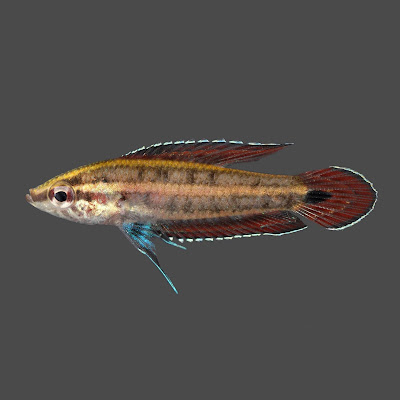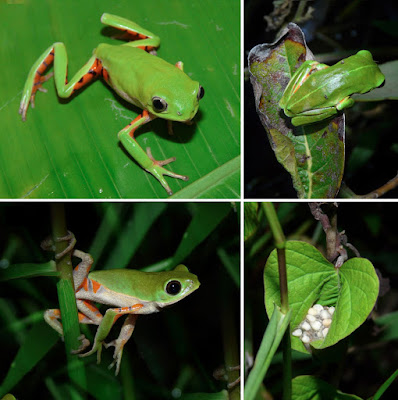[Most Recent Entries] [Calendar View]
Tuesday, November 10th, 2020
| Time | Event | ||||
| 8:41a | [Ichthyology • 2020] Parosphromenus barbarae • A New Species of Licorice Gourami (Anabantiformes: Osphronemidae) from Sarawak, Borneo
In Sarawak, there are two main populations of Parosphromenus known, the eastern population linked to the Rejang River basin being P. allani, and the western population linked to the Batang Kayan basin, is herein described as P. barbarae, new species. Parosphromenus barbarae differs from its most similar species, P. allani, in having a distinct black ocellus on caudal-fin base, indistinct dark brown ocellus on posterior base of dorsal-fin; presence of clearly demarcated subdistal hyaline band on anal fin (vs. faint); dorsal-fin rays XI – XIV, 4 – 5 (total count 15 – 18, mode 17); anal-fin rays XI – XIII, 6 – 10 (total count 19 – 21, mode 21); lateral scales 29 – 31½ (mode 29). Key words: Allopatric speciation, Anabantiformes, biodiversity, peat swamps, Southeast Asia.
Parosphromenus barbarae, new species Diagnosis. Parosphromenus barbarae can be differentiated from its congeners with the following unique combination of characters: presence of faint ocellus on posterior base of dorsal-fn; presence of distinct ocellus on caudal fn base; presence of distinct three cream and two and half dark brown stripes on body; dorsal-fn rays XI –XIV, 4 –5 (total count 15 – 18, mode 17); anal-fn rays XI –XIII, 6–10 (total count 19–21, mode 21); lateral scales 29–31½ (mode 29). Distribution. This species is currently known only from the remnant peat swamp forest near Batang Kayan in Lundu, near the western tip of Sarawak (Fig. 4). Etymology. Named for Barbara Brown, spouse of Allan Brown, who frst collected this species. This is the allopatric species to P. allani, being found in southern Sarawak, east of the Lupar divide. Tan Heok Hui and Jongkar Grinang. 2020. Parosphromenus barbarae, A New Species of Licorice Gourami from Sarawak, Borneo (Teleostei: Osphronemidae). Vertebrate Zoology. 70(3); 349-356. DOI: 10.26049/VZ70-3-2020-07 | ||||
| 2:38p | [Herpetology • 2020] Pithecopus gonzagai • A New Cryptic Species of Pithecopus (Anura, Phyllomedusidae) in north-eastern Brazil
ABSTRACT The genus of Neotropical frogs Pithecopus includes 11 species occurring east of the Andes from southern Venezuela to northern Argentina. Recent genetic approaches pointed out an unusual genetic diversity among populations from localities in north-eastern Brazil recognized as P. nordestinus. In fact, one of these studies confirmed the hypothesis that the São Francisco River acted as an effective geographical barrier during vicariant events in the evolutionary history of P. nordestinus, resulting in two principal, highly divergent clades. Herein we formally describe this divergent clade as a new cryptic species of Pithecopus from north-eastern Brazil, the sister clade of P. nordestinus. It differs from other species of Pithecopus, except for P. azureus and P. nordestinus, by its small body size, lack of the reticulate pattern on flanks, smaller head width, and advertisement calls generally composed of a three-pulsed core. Keywords: integrative taxonomy, Pithecopus nordestinus, São Francisco River, phenotypically cryptic species Class Amphibia Linnaeus, 1758 Order Anura Fischer von Waldheim, 1813 Family Phyllomedusidae Günther, 1858 Genus Pithecopus Cope, 1866 Pithecopus gonzagai sp. nov. Diagnosis: Pithecopus gonzagai sp. nov. is assigned to the genus Pithecopus (former Phyllomedusa hypochondrialis species group; Caramaschi 2006) by the following set of characters: (1) small body size; (2) dorsolateral macroglands (sensu Antoniazzi et al. 2013) indistinct; (3) smooth skin on back and granulose on belly; (4) fingers and toes long and slender with terminal discs poorly developed; and (5) grasping (opposable to the others) finger I and toe I. Pithecopus gonzagai sp. nov. differs from the highland species of Pithecopus by the (6) lack of the reticulate pattern on flanks, and (7) head width smaller than 11.2 mm. Etymology: The specific name honours Luiz Gonzaga do Nascimento, better known as Luiz Gonzaga. He was a Brazilian singer, songwriter, musician, poet and one of the most influential figures of Brazilian popular music in the twentieth century. Luiz Gonzaga has been credited for presenting the rich universe of north-eastern musical genres to the rest of the country. He was born and raised in the municipality of Exu, state of Pernambuco, Brazil. Pithecopus gonzagai sp. nov. also occurs in the state of Pernambuco, which is equally its type locality. Felipe Silva de Andrade, Isabelle Aquemi Haga, Johnny Sousa Ferreira, Shirlei Maria Recco-Pimentel, Luís Felipe Toledo and Daniel Pacheco Bruschi. 2020. A New Cryptic Species of Pithecopus (Anura, Phyllomedusidae) in north-eastern Brazil. European Journal of Taxonomy. 723(1), 108-134. DOI: 10.5852/ejt.2020.723.1147 |
| << Previous Day |
2020/11/10 [Calendar] |
Next Day >> |





